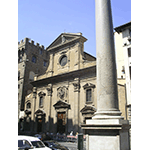Church of Santa Trinita
This basilica, founded by the Vallombrosan Order, was built during the 11th century. It was enlarged in the Gothic style during the first thirty years of the 14th century and later on from the end of that century till about 1405. The outside facing in hard sandstone, designed at the end of the 16th century (1593-1594) by Bernardo Buontalenti, displays a double order of composite pilasters, and at its upper central point there is a round window.
The interior, with its Gothic plan in the form of an Egyptian cross, was revamped during the 17th century. It consists of three naves separated by pilasters, with five chapels on either side, four at the end and a square apse. It houses countless artworks, among which these should be noted: in the right-hand nave the fourth chapel is decorated with frescoes by Lorenzo Monaco, painted 1420-1425, and with a wood-panel painting of the Annuciation by the same artist; and in the right transept there is the Sassetti chapel, frescoed by Domenico Ghirlandaio and his workshop between 1483 and 1486 with Episodes from the Life of Saint Francis of Assisi.
In one of the manuscript versions of his Racconto istorico della vita di Galileo Galilei Vincenzo Viviani writes that young Galileo «learned the precepts of logic from a Vallombrosan teacher of S. Trinita», although this detail does not appear in the printed text. Whether Galileo completed his first studies in Florence at Santa Trinita or at the Vallombrosa Monastery was apparently a debated issue even among his contemporaries.
****************************
Texts by Nicoletta Baldini
English translation by Edward Tosques
Last update 16/apr/2009




